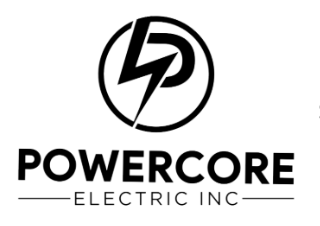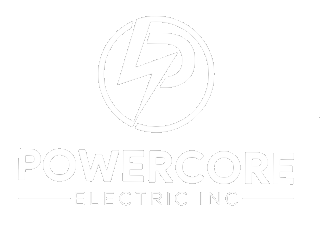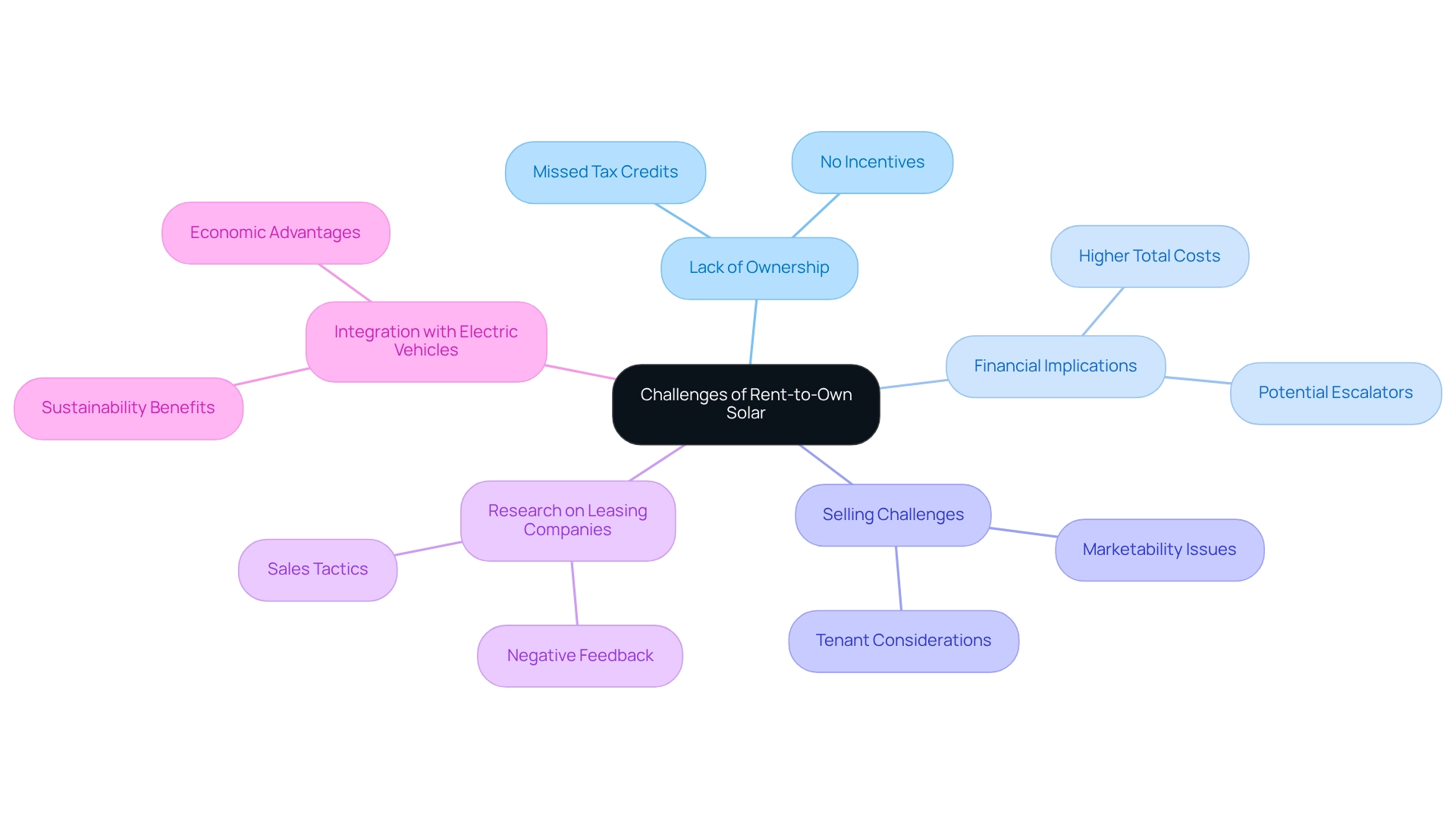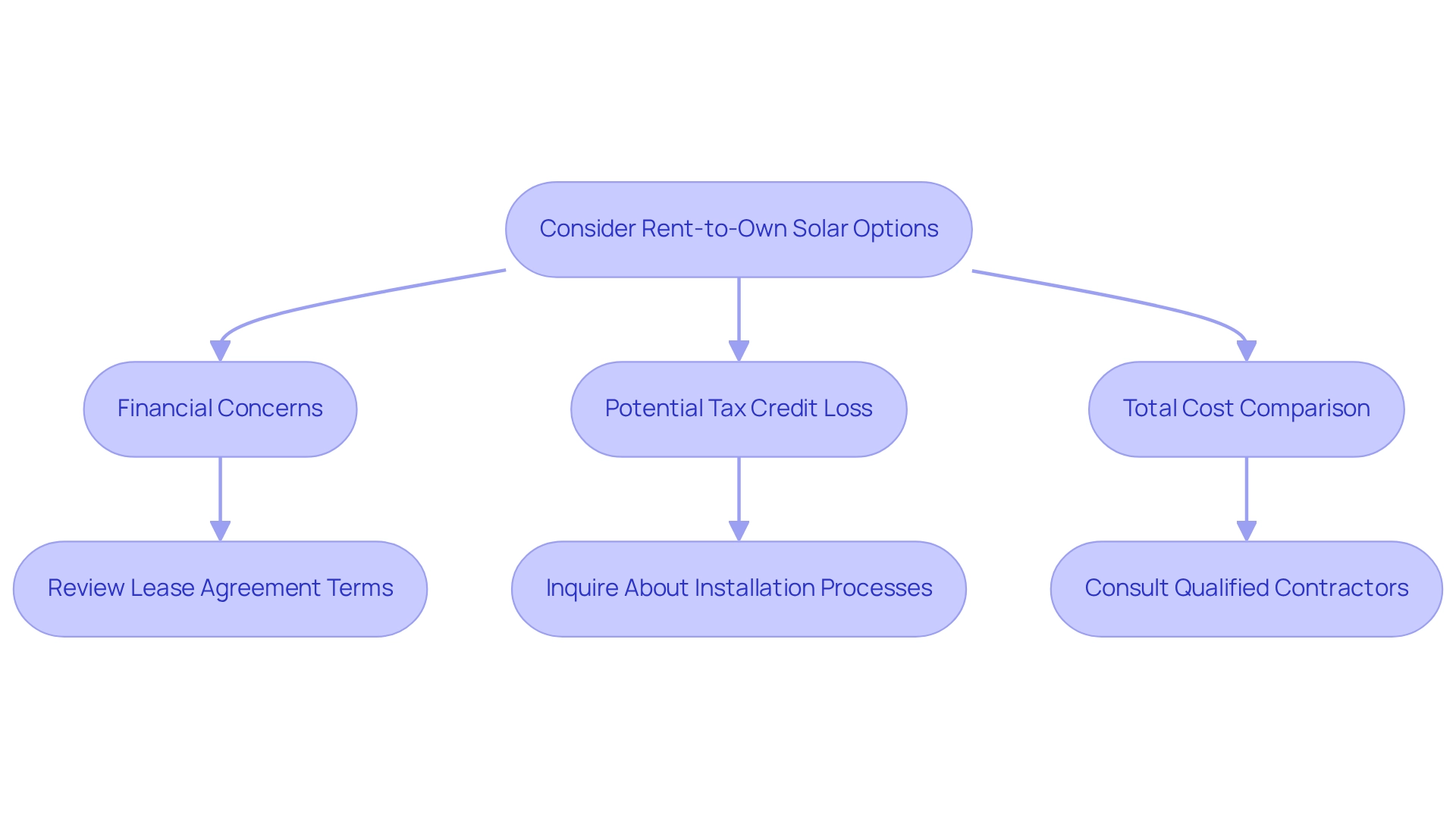Overview
We understand that managing energy bills can be a significant concern for homeowners. Rent-to-own solar options offer a compassionate solution, providing access to renewable energy without the burden of hefty upfront costs. This means you can start saving on your electricity bills right away, while also paving the way toward full ownership at the end of your lease.
Imagine the relief of lower monthly payments compared to traditional utility costs. It’s common to feel apprehensive about such decisions, so we want to highlight the financial benefits that come with solar energy. However, it’s also important to consider potential drawbacks, like the loss of tax credits. We encourage you to carefully review contract terms, ensuring you make informed decisions that align with your goals.
Together, we can explore these options and find the best path for your energy independence. If you have questions or need guidance, don’t hesitate to reach out. Your journey towards sustainable energy solutions is just a conversation away.
Introduction
In a world increasingly focused on sustainability and cost-effectiveness, many homeowners find themselves concerned about the rising costs of energy bills. Rent-to-own solar systems present a transformative solution, allowing individuals to embrace renewable energy without the heavy burden of upfront investments. This innovative financing model enables you to enjoy the benefits of solar power while making manageable monthly payments, ultimately leading to ownership of the system.
As California leads the charge in solar adoption, it’s heartening to note that nearly a third of new installations are now financed through rent-to-own agreements. This shift reflects a growing movement towards accessible energy solutions that can empower you to take control of your energy future. However, we understand that while the advantages are compelling, potential pitfalls may also lurk beneath the surface. It’s common to feel uncertain about making such a significant decision, which is why it’s essential to fully grasp your options and the implications of your choices.
This article aims to delve deeply into the mechanics of rent-to-own solar systems, exploring their benefits, challenges, and the crucial factors you should consider before making the leap into solar energy. Together, we can navigate this journey towards energy independence, ensuring you feel supported and informed every step of the way.
What is Rent-to-Own Solar?
Are you feeling overwhelmed by rising energy bills? Rent to own solar options for photovoltaic systems offer a groundbreaking financing method that can alleviate those concerns. This innovative model allows property owners to install energy panels without the substantial initial expenses typically associated with direct acquisitions. By entering into a contract that requires monthly payments over a specified period, homeowners can immediately enjoy the benefits of renewable power. At the end of the agreement, you have the opportunity to purchase the renewable energy setup at a fixed price, transitioning from a rental arrangement to complete ownership.
This method is particularly beneficial for those who may not have the funds for a direct acquisition, making renewable energy more accessible to a wider audience. In California, the market for rent to own solar options has seen significant growth, with around 30% of new installations in the state funded through these agreements in 2025. This trend highlights the increasing demand for adaptable financing alternatives that meet homeowners’ needs.
Successful case studies showcase the effectiveness of rent to own solar options for energy systems. For instance, in Lemoore, California, boasts a capacity of 325 MW, supplying power to over 90,114 homes. This demonstrates the scalability and reliability of renewable power solutions. Homeowners who choose rent to own solar options benefit not only from reduced utility expenses but also from the chance to adopt sustainable practices without the burden of significant upfront costs.
If you’re environmentally conscious and reside in areas like Stockton or Long Beach, understanding local photovoltaic firms and their offerings can further enhance your renewable journey. Powercore Electric stands out among local providers, delivering high-quality installations and maintenance. Their team of specialists ensures that you receive customized solutions, including specific panels designed for optimal efficiency—even on overcast days.
Customer testimonials reflect satisfaction with Powercore Electric’s services, emphasizing their commitment to quality and customer care. Together, we can explore how rent to own solar options represent a viable pathway for homeowners like you, looking to enhance energy independence while contributing to a more sustainable future. Are you ready to take the next step towards energy independence? Let’s work together to make your renewable energy dreams a reality.
How Rent-to-Own Solar Works
Are you feeling overwhelmed by rising energy bills? In a rent-to-own energy agreement, property owners can find a supportive solution. By entering into a contract with a provider, such as Powercore Electric, you can have solar panels installed on your premises. This arrangement typically involves a set monthly charge for utilizing the solar setup, which often includes maintenance and monitoring services, alleviating you from additional responsibilities. In California, these contracts usually last from 15 to 25 years.
At the conclusion of the term, you have several options:
- Purchase the system at a discounted rate
- Continue renting
- Choose to have the system removed
It’s essential to thoroughly review the contract terms, as some agreements may include escalators that gradually increase monthly payments over time. As Rusty Rumley, a Senior Staff Attorney, wisely advises, “It is essential to have a lawyer who is informed about lease agreements to thoroughly examine the contract for the landowner because once the agreement is signed, it is quite challenging to implement any modifications.”
Recent trends show a growing interest in for renewable installations, especially since the U.S. government has extended the Investment Tax Credit (ITC) for such projects, offering a 30% tax credit for these systems. This financial incentive makes renewable energy more accessible, encouraging homeowners to consider these agreements as a viable path to energy independence. Understanding the key elements of rent-to-own solar options is crucial.
Homeowners should be aware of the structures of these agreements, which often include provisions for maintenance, performance guarantees, and potential buyout options. Additionally, willingness to pay estimates reveal varying preferences among property investors regarding system costs and financial policies. Engaging with informed providers like Powercore Electric can help clarify these aspects, ensuring that you make educated choices that align with your objectives while benefiting from local expertise and sustainable solutions.
At Powercore Electric, we pride ourselves on our unmatched quality craftsmanship and commitment to your satisfaction. Our clients have shared their positive experiences, highlighting how our tailored service and attention to detail have made their transition to renewable power effortless. Don’t miss out on the opportunity to harness the potential of sunlight energy for your home.
Let’s work together to get your free, personalized estimate today!
Financial Considerations: Monthly Payments and Savings
When considering rent-to-own solar options, we understand that property owners often have concerns about monthly charges compared to their existing electricity expenses. Typically, these payments are structured to be lower than average monthly utility costs, enabling homeowners to realize savings from the very beginning. Many rent-to-own agreements also encompass maintenance and monitoring services, which can help mitigate unexpected expenses.
However, it’s common to feel apprehensive about potential escalators in the contract that may lead to increased payments over time. A thorough financial evaluation shows that, although the upfront expenses of rent-to-own arrangements may appear attractive, it’s vital to contrast the overall expense of the contract with the option of buying a unit outright. This comparison is especially important in California, where regional energy costs can significantly affect long-term savings.
For instance, the typical expense of an 11 system is around $20,552 after federal tax credits, and residents can benefit from several incentives that further decrease this expense. Additionally, electrical panel enhancements for photovoltaic systems can range from $2,000 to $3,000, which is a significant factor for total investment. Research shows that renewable energy systems can boost a property’s worth by around $15,000, based on findings from Lawrence Berkeley National Laboratory, making this investment even more appealing.
Moreover, it’s essential to consider that evaluating several energy quotes can result in savings of up to 20% on installation expenses, further improving the financial feasibility of renewable energy investments. Ultimately, property owners should compare the average monthly payments for rent-to-own solar options with their conventional utility expenses to identify the most financially beneficial choice. By doing so, they can make informed decisions that align with their power requirements and financial objectives, while also understanding the broader context of renewable resource costs and benefits. Together, we can navigate these choices to find the best path toward energy independence and sustainability.
Advantages of Rent-to-Own Solar Systems
Are you feeling overwhelmed by rising energy bills? Rent-to-own solar options for photovoltaic installations offer a compassionate solution, allowing you to embrace sustainable power without the burden of significant upfront costs. By eliminating the need for a hefty initial investment, these solutions open the door to solar energy for many property owners, empowering you to transition to renewable energy sources.
One of the remarkable benefits of rent-to-own agreements is the inclusion of maintenance and monitoring services within your monthly fee. This not only provides peace of mind but also alleviates the responsibility of upkeep from your shoulders, ensuring that your solar setup operates efficiently over time. Powercore Electric’s dedicated in-house team of experts guarantees high-quality installations and maintenance, reinforcing the reliability of these systems and showcasing the company’s commitment to exceptional service in California communities.
Moreover, many property owners experience immediate reductions in their electricity expenses with rent-to-own solar options. In fact, studies reveal that a significant percentage of homeowners report lower monthly payments compared to traditional utility costs, which have surged by approximately 32% over the past decade. This trend highlights the financial feasibility of investing in renewable energy.
As Andrew Giermak points out, “Tax benefits, such as the federal renewable energy tax credit, go to the company that owns the panels you’re leasing,” underscoring the financial incentives tied to these agreements.
At the conclusion of the rental contract, you have the opportunity to fully own the energy installation, leading to years of free electricity. This long-term advantage can result in substantial savings, with potential decreases in utility expenses exceeding $100,000 over 25 years, as emphasized in the case study titled ‘Financial Viability of ,’ which evaluates the financial returns of investing in such systems compared to other investment opportunities.
For eco-conscious homeowners, rent-to-own solar options not only provide immediate financial relief but also contribute to a sustainable future. By opting for these setups, you can significantly reduce your carbon footprint while enjoying financial benefits from renewable sources. Furthermore, initiatives like EnergySage’s marketplace, developed with support from the U.S. Department of Energy, are making clean home power solutions more affordable and accessible, reinforcing the advantages of rent-to-own solar options.
Additionally, the broader economic impact of residential net metered energy installations can foster job creation and enhance public health, aligning with the goals of equitable access initiatives such as the Biden-Harris administration’s Solar for All program.
As one satisfied customer shared, “Ryan and his team were great. They were quick, effective, and kept to the timeline for our energy installation. I have referred Powercore to some friends, and they were also happy with their service. I’d definitely recommend Ryan and Powercore Electric.” This testimonial reflects the high level of customer satisfaction and service excellence that Powercore Electric strives to provide. Together, we can work towards a sustainable future, ensuring you not only save money but also contribute positively to the environment.
Disadvantages and Challenges of Rent-to-Own Solar
While may seem appealing, they come with significant drawbacks that property owners should carefully consider. We understand that the idea of solar energy can be exciting, but a primary concern is that during the rental period, property owners do not actually own the solar panels. This lack of ownership means missing out on valuable federal tax credits and other incentives typically available to those who purchase their units outright.
In fact, statistics indicate that a significant percentage of property owners miss out on tax credits due to the nature of rent-to-own agreements, which underscores the financial implications of such arrangements. It’s common to feel overwhelmed by these details, but it’s crucial to be informed.
Furthermore, the total expense of a rent-to-own contract can often exceed that of a direct purchase, particularly if the property owner opts to acquire the unit at the end of the lease period. This financial burden can be compounded by potential escalators in some agreements, leading to increased monthly payments over time, ultimately affecting long-term affordability. As financial advisor Guinn advises, “Owned setups, whether cash or financed, are the only option one should contemplate for energy solutions in their residence.”
Homeowners may also face challenges when it comes to selling their properties with a rent-to-own energy setup in place. Prospective buyers might hesitate to assume the lease, complicating the sale process and potentially diminishing the home’s marketability. Moreover, landlords should consider tenants’ willingness to pay extra rent tied to photovoltaic panels when deciding on installation, which can further complicate the dynamics of selling homes with rent-to-own agreements.
Given these factors, it is essential for property owners to thoroughly investigate and evaluate the advantages and disadvantages of rent-to-own solar options before making a decision. This ensures they select the option that best aligns with their financial objectives and power requirements. Additionally, the prevalence of negative feedback regarding major leasing firms such as Sunrun, Freedom Forever, and Trinity Solar highlights the importance of researching leasing companies before making a commitment. Concerns about aggressive sales tactics and inadequate customer support can greatly influence the property owner’s experience, making it vital to assess service providers thoughtfully to uncover the best value in renewable solutions.
Moreover, combining electric vehicles with renewable power sources can enhance the overall sustainability of a resident’s power plan. By harnessing sunlight to charge electric vehicles, residents can reduce their carbon footprint and maximize the benefits of their renewable investments. Powercore Electric offers solutions that facilitate this integration, ensuring that residents can enjoy both the economic and environmental advantages of renewable energy while operating electric vehicles.
End of Agreement: What Homeowners Need to Know
As property owners near the conclusion of their agreements, it’s common to feel a mix of anticipation and uncertainty about the next steps. One appealing choice is to purchase the photovoltaic array at a predetermined price, often set below current market value. This option allows homeowners to achieve complete ownership of the system, potentially leading to long-term reductions in energy expenses.
Many property owners report average savings of around $50 monthly from their leases, yet the actual financial benefit can vary based on specific agreements and configurations. Industry data reveals that monthly payments for photovoltaic leases can range from $75 to over $200, providing a clearer financial context for homeowners as they weigh their options.
Alternatively, extending the rental agreement is another viable path. This choice enables homeowners to continue enjoying the benefits of renewable energy without the immediate commitment of ownership. For those uncertain about the long-term viability of the system or their financial situation, this option can be particularly attractive. Regular maintenance of photovoltaic panels is crucial for ensuring efficiency and longevity, and homeowners should consider innovative cleaning methods to boost their system’s performance.
If homeowners decide against purchasing or extending the lease, the energy provider typically removes the installation at no cost, ensuring that they are not left with an unwanted fixture. It’s essential for property owners to thoroughly review their agreements to fully understand the specific terms and conditions associated with these choices.
Expert insights suggest that a significant number of homeowners opt to buy their rent-to-own solar options, driven by the desire for energy independence and the lasting financial benefits of ownership. Catherine Lane, a renewable energy industry expert, notes, ‘Leases save $50 per month on average, but it depends on the specifics of your contract.’ Understanding the nuances of rent-to-own solar options and their implications is vital for making an informed decision at the conclusion of a rent-to-own energy agreement.
Additionally, homeowners should be mindful that signing a Power Purchase Agreement (PPA) typically means they are not eligible for tax credits or incentives, which are available to the installation’s owner. This financial consideration is crucial when evaluating alternatives, especially when exploring the best battery options for efficient energy storage. Together, we can navigate these choices and work towards a sustainable energy future.
Comparing Rent-to-Own with Other Solar Financing Options
When considering financing choices for renewable energy, we understand that property owners often weigh rent-to-own solar options against other alternatives like direct acquisitions, energy loans, and leasing agreements. Acquiring a renewable energy system allows for full ownership, granting access to valuable tax credits and incentives. However, this typically requires a substantial upfront investment. On the other hand, energy loans enable homeowners to fund their acquisition, spreading the cost over time while still enjoying the benefits of ownership and potential energy savings.
As Alix Langone observes, ‘Down payments typically aren’t necessary for or photovoltaic leases, so you’ll experience immediate savings from both without needing to make a substantial cash outlay.’ This is an encouraging thought for many.
Leasing offers a different approach, characterized by low or no upfront costs and predictable monthly payments. However, it does not confer ownership or the associated tax benefits, which can limit long-term financial advantages. Rent-to-own solar options seek to bridge this gap, providing a pathway to ownership without the immediate financial burden.
While this model can facilitate access to solar energy, it may not yield the same level of long-term savings as outright purchases or loans. We encourage homeowners to notify their insurance companies about energy installations to ensure coverage, protecting their investment.
Statistics suggest that a residence fitted with photovoltaic panels may fetch roughly 4% more on the market compared to a similar home lacking them, emphasizing the possible value increase from such investments. Additionally, property owners should be aware that renting photovoltaic panels often leads to reduced long-term savings, as the rental firm retains all tax incentives and refunds.
In recent years, an increasing number of property owners have opted for rent-to-own solar options instead of conventional financing or leases, indicating a shift in preferences towards more adaptable funding solutions. Expert opinions suggest that while rent-to-own can be appealing due to its lower initial costs, it is essential for homeowners to carefully consider their long-term financial goals and the implications of each financing option.
Case studies show that the process of obtaining photovoltaic panels generally includes multiple phases:
- Consultation and assessment of financial and power requirements
- Designing a customized panel system
- Securing funding
- Installation
Property owners who decide to buy photovoltaic panels gain complete ownership, enabling them to take advantage of savings on utilities and financial benefits, ultimately leading to considerable long-term savings. This thorough understanding of renewable energy financing choices empowers property owners to make informed decisions that align with their energy needs and financial goals.
Furthermore, it is beneficial for homeowners to explore different energy service providers, comparing their offerings and financing alternatives to uncover the best value. For newcomers, resources like tutorials on renewable energy financing can provide essential insights, simplifying the decision-making process. Together, we can navigate these options to find the best path forward.
Key Takeaways for Homeowners Considering Rent-to-Own Solar
Homeowners in California who are considering rent-to-own solar options often find themselves grappling with financial concerns and the desire for sustainable energy solutions. We understand that the prospect of can be daunting. One of the main benefits of these setups is the absence of initial expenses, which allows for prompt savings on electricity bills. Additionally, many agreements provide the potential for ownership at the end of the lease term, making this an attractive option for those eager to invest in renewable energy.
However, it’s essential to be aware of the potential drawbacks. For example, property owners may miss out on valuable tax credits typically available with outright purchases, and the total cost over the lease period could surpass that of acquiring a system outright. A recent study indicates that while photovoltaic leases can save property owners an average of $50 per month, the specifics of each agreement can significantly impact total savings, as highlighted by energy industry expert Catherine Lane.
To make an informed decision, homeowners should carefully review the terms of their lease agreements and compare them with other financing options. Key considerations include:
- Understanding the implications of demand charges
- The importance of collaborating with qualified contractors
- The potential for subcontracted installations, which may affect the quality of work
It’s common to feel uncertain about these details, so customers should inquire about installation processes before signing.
At Powercore Electric, we pride ourselves on our local expertise and unmatched quality craftsmanship, ensuring that every installation meets the highest standards of quality, safety, and efficiency. Our customer-first approach guarantees that your satisfaction is our priority, making your experience seamless and stress-free. As one pleased customer shared, “Powercore Electric changed our power consumption and made the process so simple!”
Case studies, like the one titled ‘Key Considerations for Solar Power,’ emphasize the importance of being well-informed about renewable power systems and the typical pitfalls in the market. By leveraging knowledge from solar industry specialists, residents can more effectively navigate the intricacies of rent-to-own solar options, ensuring that their decisions align with both their financial and sustainability objectives. Furthermore, with rising power costs—evidenced by Hawaii’s average annual electricity rate increase of 4.58%—the urgency for sustainable power solutions becomes even more apparent.
Ultimately, a careful evaluation of these factors will empower property owners to make decisions that enhance their energy independence and contribute to sustainable living. Together, we can work towards a brighter, more sustainable future.
For personalized estimates or consultations regarding solar leasing options, we encourage homeowners to reach out to Powercore Electric today.
Conclusion
We understand that many homeowners are concerned about rising energy bills and are looking for sustainable solutions that won’t break the bank. Rent-to-own solar systems present a compassionate pathway for those eager to embrace renewable energy without the significant upfront costs associated with outright purchases. This financing model allows you to enjoy the benefits of solar power through manageable monthly payments, often leading to immediate savings on your energy bills. In California, for instance, nearly a third of new solar installations are financed through these agreements, reflecting a growing accessibility to sustainable energy solutions that empower you to take control of your energy future.
While the benefits are compelling, it’s common to feel apprehensive about the potential drawbacks of rent-to-own agreements. The lack of ownership during the rental period may mean missing out on valuable tax credits and other incentives typically available to those who purchase their solar systems outright. Additionally, understanding the terms of the contract, including any potential escalators in monthly payments, is essential for making informed financial decisions. We encourage you to conduct thorough research and compare various financing options to ensure that your choice aligns with your long-term financial goals and energy needs.
Ultimately, the decision to opt for a rent-to-own solar system should be made with careful consideration of all factors involved, including the potential for ownership, the financial implications, and the quality of service provided by solar companies. By leveraging local expertise and understanding the intricacies of solar financing, you can navigate the path toward energy independence and contribute to a more sustainable future. Embracing renewable energy not only benefits your household but also plays a crucial role in creating a greener planet for generations to come. Together, let’s work towards a brighter, more sustainable future.





